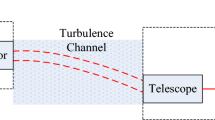Abstract
Wireless communication using free space optics (FSO) is becoming attractive for data transmission purposes. However, the system performance gets affected by atmospheric factors such as turbulence which induces beam wander effect thus degrading the reliability of FSO links. A turbulence simulation experiment is performed in laboratory to study the beam wander effect. A statistical prediction model for beam wander effect in a turbulent FSO link is presented. Based on this model, outage calculations are performed and compared against experimental values. The decline in outage due to increase in aperture area is computed both for predicted as well as experimental values. The results show similarity in both the values for small aperture sizes but differ for larger ones.







Similar content being viewed by others
References
Goodwin, F. E. (1970). A review of operational laser communication systems. Proceedings of the IEEE,58(10), 1746–1752.
Nor, N. A. M., Ghassemlooy, Z., Zvanovec, S., Khalighi, M. A., Bhatnagar, M. R., Bohata, J., et al. (2019). Experimental analysis of a triple-hop relay-assisted FSO system with turbulence. Optical Switching and Networking,33, 194–198.
Babani, S., Bature, A. A., Faruk, M. I., & Dankadai, N. K. (2014). Comparative study between fiber optic and copper in communication link. International Journal of Technical Research and Application,2, 59–63.
Nistazakis, H. E., Tsiftsis, T. A., & Tombras, G. S. (2009). Performance analysis of free-space optical communication systems over atmospheric turbulence channels. IET Communications,3(8), 1402–1409.
Hocking, W. K. (1985). Measurement of turbulent energy dissipation rates in the middle atmosphere by radar techniques: A review. Radio Science,20(6), 1403–1422.
Latteck, R., Singer, W., & Hocking, W. K. (2005). Measurement of turbulent kinetic energy dissipationrates in the mesosphere by a 3 MHz Doppler radar. Advances in Space Research,35(11), 1905–1910.
Popoola, W. O., Ghassemlooy, Z., Lee, C. G., & Boucouvalas, A. C. (2010). Scintillation effect on intensity modulated laser communication systems—A laboratory demonstration. Optics & Laser Technology,42(4), 682–692.
Kaushal, H., & Kaddoum, G. (2016). Optical communication in space: Challenges and mitigation techniques. IEEE Communications Surveys & Tutorials,19, 57–96.
Andrews, L. C., Phillips, R. L., Sasiela, R. J., & Parenti, R. R. (2006). Strehl ratio and scintillation theoryfor uplink Gaussian-beam waves: Beam wander effects. Optical Engineering,45(7), 076001-1–076001-12.
Churnside, J. H., & Lataitis, R. J. (1990). Wander of an optical beam in the turbulent atmosphere. Applied Optics,29(7), 926–930.
Kaur, G., Singh, H., & Sappal, A. S. (2017). Free space optical using different modulation techniques—A review. International Journal of Engineering Trends and Technology (IJETT),43(2), 105–109.
Zhu, X., Kahn, J. M., & Wang, J. (2003). Mitigation of turbulence-induced scintillation noise in free-space optical links using temporal-domain detection techniques. IEEE Photonics Technology Letters,15(4), 623–625.
Zhu, X., & Kahn, J. M. (2003). Markov chain model in maximum-likelihood sequence detection for free-space optical communication through atmospheric turbulence channels. IEEE Transactions on Communications,51(3), 509–516.
Abtahi, M., Lemieux, P., Mathlouthi, W., & Rusch, L. A. (2006). Suppression of turbulence-induced scintillation in free-space optical communication systems using saturated optical amplifiers. Journal of Lightwave Technology,24(12), 4966–4973.
Goyal, P., Kumar, A., & Nath, V. (2015). Mitigation of atmospheric turbulence in free space optics: A review. In Presented at the 2015 fifth international conference on advanced computing & communication technologies (ACCT) (pp. 634–640). IEEE.
Hulea, M., Ghassemlooy, Z., Rajbhandari, S., & Tang, X. (2014). Compensating for optical beam scattering and wandering in FSO communications. Journal of Lightwave Technology,32(7), 1323–1328.
Majumdar, A. K., & Gamo, H. (1982). Statistical measurement of irradiance fluctuations of a multipass laser beam propagated through laboratory-simulated atmospheric turbulence. Applied Optics,21(12), 2229–2235.
Hudcova, L., & Barcik, P. (2012). Experimental measurement of beam wander in the turbulent atmospheric transmission media. In Proceedings of 22nd international conference radioelektronika 2012 (pp. 1–4). IEEE.
Kaushal, H., Kumar, V., Dutta, A., Aennam, H., Jain, V. K., Kar, S., et al. (2011). Experimental study on beam wander under varying atmospheric turbulence conditions. IEEE Photonics Technology Letters,23(22), 1691–1693.
Ishimaru, A. (1969). Fluctuations of a beam wave propagating through a locally homogeneous medium. Radio Science,4(4), 295–305.
Qiang, X., Li, Y., Zong, F., & Zhao, J. (2009). Measurement of laboratory-simulated atmospheric turbulence by PSD. In 9th International conference on electronic measurement & instruments (pp. 2–90).
Andrews, L. C., Phillips, R. L., & Hopen, C. Y. (2001). Laser beam scintillation with applications (Vol. 99). Bellingham: SPIE Press.
Acknowledgements
This study has been financially supported by Dept. of Electronics Technology, Guru Nanak Dev University, Amritsar.
Author information
Authors and Affiliations
Corresponding author
Additional information
Publisher's Note
Springer Nature remains neutral with regard to jurisdictional claims in published maps and institutional affiliations.
Rights and permissions
About this article
Cite this article
Priyanka, Singh, M.L., Gill, H.S. et al. An Experimental Evaluation of Link Outage Due to Beam Wander in a Turbulent FSO Link. Wireless Pers Commun 113, 2403–2414 (2020). https://doi.org/10.1007/s11277-020-07333-y
Published:
Issue Date:
DOI: https://doi.org/10.1007/s11277-020-07333-y




